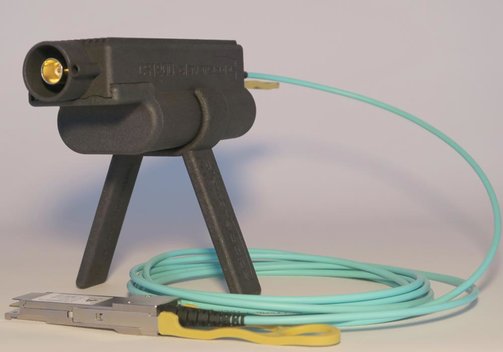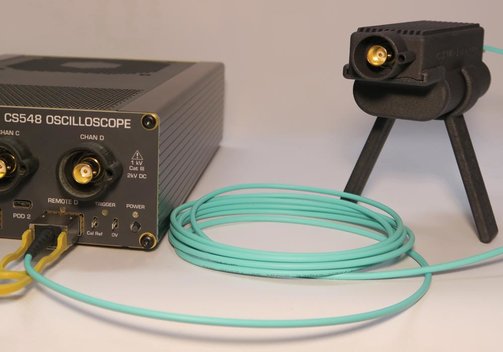Cleverscope CS1200 and CS1300 Pods and Accessories
Cleverscope CS1200 and CS1300 Pods and Accessories
The Cleverscope pods are used to extend the capability of the CS548 oscilloscope. Two pod connectors are provided on the CS548. Pods use LVDS communications capable of 400 Mbps for good noise immunity, low EMI, and reliability.
Model Overview
| Model | Description |
| CS1200 | Battery powered, active fibre optic linked remote digitizer for CS548. Additional description see below |
| CS1201 | Battery powered, active fiber optic linked remote current digitizer for CS548. Additional description see below |
| CS1133 | ▸Vsat probe |
| CS1124 | Link port expansion: Used to expand the CS548 or CS448 link port to serve up to 4 linked devices. The CS1124 allows the CS548 to read the ID of each linked device, and operate appropriately |
| CS1301-1 CS1301-2 | Isolated digital input pod 1 and 2: Isolated 4x input pod for channels 1-4 and 5-8. Additional description see below |
| CS1501 | CS1501 1 mΩ current shunt |
| CS1308 | Isolated digital input pod: Fiber isolated 4x input pod |
| CS1302 | Isolated digital I/O pod: Isolated 4x output 1x input pod |
| CS1309 | Isolated digital I/O pod: Fiber isolated 4x output 1x input pod |
| CS1026 | Fiber cable for CS1200, availabe as -1 (1 m), -3 (3 m), -5 (5 m), -10 (10 m), -20 (20 m), -30 (30 m) |
| CS1027 | Fiber cable for CS1308 and CS130, available as -1 (1 m), -10 (10 m) |
| CS1102 | CS548 test fixtures - three boards, one for low impedance (1 mΩ...1 k&Oega;), another for high impedance (1 Ω...25 kΩ), and the third for transformer testing (B-H, X primary, X leakage, Cww, N, and Xmutual) |
Cleverscope CS1200 Digitizer
- 30 kV isolation provided >150 mm spacing between IsoPod and other structures.
- 2 pF free space capacitance >50 mm above reference plane.
- 100 dB CMRR at 50 MHz.
- 14 bit resolution, 100 dB dynamic range.
- 200 MHz analog bandwidth.
- 100 µV resolution on 0.8-V range.
- 200 µVRMS noise on 0.8-V range.
Cleverscope CS1201 Digitizer and Shunt CS1501
The current digitizer measures current with a CS1501 resistive shunt sensor. One CS1501 and the probe cable is included. It is battery powered and capable of operating up to 30 m over an active optical link cable. Comes with a choice of 1 m, 3 m, 5 m, 10 m, 20 m, or 30 m cable. Capable of 30 kV isolation.
- 30 kV isolation provided >150 mm spacing between digitizer and other structures.
- Pod enclosure isolation to BNC >1 kV.
- 2 pF free space capacitance >50 mm above reference plane.
- 140 dB CMRR at 50 MHz.
- 14 bit resolution, 100 dB dynamic range.
- 200 MHz analog bandwidth.
- Two hardware ranges: ±63 A with 63 mA resolution continuous square wave, ±630 A with 630 mA resolution DPT only.
- 2 Ω compensated input impedance.
CS1301 Isolated Digital Inputs
The pod supports 4 isolated digital inputs with one common, and fixed voltage threshold of Vhi > 2.3 V, with +18, -15 V overload protection. Isolation is 600 VRMS CAT III (UL), or 800 VDC (VDE), based on an ISOW7844FDWE, and PCB creepage. Common mode rejection is 100 V/ns.
CS1302, CS1308, CS1309 Isolated Digital-I/O
Model Overview
| Model | Cleverscope CS1302 | Cleverscope CS1308 | Cleverscope CS1309 |
| Inputs | 1 | 4 | 1 |
| Output | 4 one of which may be assigned as a high speed clock | - | 4 |
| Specs | The pod allows high speed generation of arbitrary signals, optionally synched to the clock, with simultaneously recording of the input signal. It may also be used as a fast isolated SPI or UART port. The application supports arbitrary pulse generation, PWM, and double pulse testing using the CS1302. Output level 5 V (VSEL open), or 3 V3 (VSEL pulled low). Isolation: 600 VRMS CAT III (UL), or 800 DC (VDE), based on an ISO7840DW and ISOW7744DFMR, and PCB creepage. Common mode rejection 100 V/ns. | Similar operation to the CS1301 but with fiber connections for greater isolation. Requires CS1027 fibers purchased separately. Data transmission at signal rates from DC up to 50 MBd. Can be used with digital signals from DC to 25 MHz. Up to 50 m distance with 1 mm polymer optical fiber. These modules should be included in the device being tested, for example a gate driver board. | |
| Transmitter module for CS1308 inputs is versatile link fiber optic transmitter AFBR-1624Z | Receiver module for CS1309 output is versatile link fiber optic receiver AFBR-2624Z; transmitter module for CS1308 inputs and CS1309 input is versatile link fiber optic transmitter AFBR-1624Z | ||
Information on product safety:
Manufacturer:
Cleverscope Ltd, Level 2, 101 Mt Eden Road, Mt Eden, Auckland 1025/NZL
www.cleverscope.com
Responsible person:
Meilhaus Electronic GmbH, Am Sonnenlicht 2, 82239 Alling/DEU
info@meilhaus.com
Related Products
Last seen



































